December 15, 2006
Air Date: December 15, 2006
FULL SHOW
SEGMENTS
Study Raises Concern About Chicken
View the page for this story
A study by Consumer Reports says more than 80 percent of chicken they inspected were contaminated with bacteria and that the U.S. Department of Agriculture is lax in their testing. Host Bruce Gellerman talks with Jean Halloran, director of Food Policy Initiatives at Consumers Union about why bacteria numbers are on the rise and what it means for consumers. (06:00)
POPsible Nightmare
View the page for this story
A recent study suggests that high body levels of persistent organic pollutants, also known as POPs, may be linked to increased risk of diabetes. Host Bruce Gellerman talks to POPs expert Dr. David Carpenter of the State University of New York at Albany about the findings. (06:00)
Conserving the Rainforest
View the page for this story
Brazil has created the largest tropical rainforest preserve in the world, setting aside an area of the Amazon larger than England for conservation and sustainable use. Host Bruce Gellerman talks with Dr. Claudio Maretti of the World Wildlife Fund about the long road to preservation, and his hopes for the future of the forest. (05:00)
Transient Paper
View the page for this story
Xerox researchers have created an experimental paper that erases itself. Dr. Paul Smith of the Xerox Research Center of Canada tells host Bruce Gellerman about the erasable paper. (03:30)
Listener Letters
View the page for this story
We dip into our mailbag to hear from our listeners. (02:00)
A Whale of a Tale
View the page for this story
Lynne Cox has made a name for herself as a long distance swimmer. She’s swam the English Channel, the Bering Strait, and braved the frigid waters of the Antarctic Ocean. But it was during an early morning workout when she was a teenager that Cox had one of her most memorable experiences: an encounter with a baby gray whale. It’s the subject of her new book “Grayson.” Lynne Cox shares her story with Living on Earth’s Ashley Ahearn. (06:00)
Emerging Science Note/Better Breathing Babies
/ Jennifer PercyView the page for this story
New research shows that living with two or more dogs may reduce a baby's chances of developing allergies. Jen Percy reports. (01:30)
Independent Nation
/ Lars BevangerView the page for this story
The Swedish government offers many incentives for consumers who drive alternative fuel vehicles. And as Lars Bevanger of Radio Deutsche Welle reports from Stockholm, Swedes are now ahead of the pack in Europe in buying environmentally-friendly cars. (05:30)
Driving Electric
/ Ingrid LobetView the page for this story
The electric car may not be dead. A number of small startup companies are launching a new generation of electric vehicles. Living on Earth’s Ingrid Lobet reports that one company called Phoenix Motorcars will soon be offering an electric pickup truck and an SUV that use a unique type of battery. (05:30)
Judgement Day
View the page for this story
“Heaven help us,” advises satirist Rich Pliskin and his Players of Princeton, New Jersey. If admission past the pearly gates depends on what we drive, some of us may be in trouble. (02:30)
| Holiday Promo/Season of Light |
|
||||
| In this preview of Living on Earth’s annual holiday storytelling special, Mara Freeman of the British Isles tells the Celtic tale of the cold, bitter goddess Cailleach who won’t easily give up her hold on the long, dark days of winter. 02:30 | |||||
-->
This week's EarthEar selection
listen /
download
Red Deer Stags roar alongside a rushing river
Show Credits and Funders
Show Transcript
HOST: Bruce Gellerman
GUEST: Lynne Cox, Dr. David Carpenter, Mara Freeman, Sally Grant, Jean Halloran, Dr. Claudio Maretti, Rich Pliskin, Dr. Paul Smith
REPORTER: Lars Bevanger, Ingrid Lobet
SCIENCE NOTE: Jennifer Percy
[THEME]
GELLERMAN: From Public Radio International - this is Living on Earth.
[THEME]
GELLERMAN: I’m Bruce Gellerman.
After finding that most of the chickens it inspected are infected with bacteria, a consumer group cries foul.
HALLORAN: What this means for the consumer is you have to assume that the chicken you buy is contaminated with something that can make you sick.
GELLERMAN: But is it just a Chicken Little warning? Federal regulators say safety standards aren’t falling. Also, strong evidence that obesity might not be the cause of diabetes. It could be due to organic pollutants.
CARPENTER: This is the same issue from Silent Spring. We have not really appreciated how dangerous these substances are to human health. And now we’re reaping the grim harvest of these exposures that we all have to these compounds.
GELLERMAN: And cars get a boost from a new kind of battery. Could this be the holy grail of electric cars? These stories and more this week on Living on Earth. Stick around!
[NPR NEWS CAST]
ANNOUNCER: Support for Living on Earth comes from the National Science Foundation and Stonyfield Farm.
[LIVING ON EARTH THEME]
Study Raises Concern About Chicken
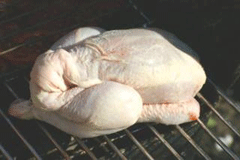
GELLERMAN: From the Jennifer and Ted Stanley Studios in Somerville, Massachusetts - this is Living on Earth. I’m Bruce GELLERMAN. Americans love chicken: fried, broiled, barbecued, grilled, fricasseed, or fashioned into fingers. Last year nine billion birds were slaughtered in U.S. processing plants. That’s nearly 90 pounds of chicken per person.
But a new study by the magazine Consumer Reports says what’s on most of the chicken is enough to make you sick.
They found more than 80 percent of the broilers they inspected were contaminated with bacteria even some organically raised chicken were infected with salmonella and campylobacter. Joining me is Jean Halloran, Director of Food Policy Initiatives at Consumer’s Union which publishes the magazine. Ms. Halloran, welcome to Living on Earth.
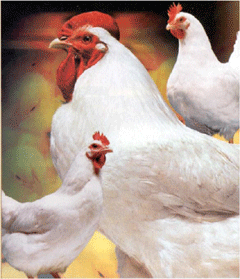
HALLORAN: Thank you.
GELLERMAN: This is the ninth time Consumer Reports had conducted this study, am I right?
HALLORAN: We’ve been testing since 1998 and these are the worst results we’ve gotten yet.
GELLERMAN: But you found what, more than 83 percent of the chickens you inspected were infected with these bacteria.
HALLORAN: Yes. It was pretty discouraging. 83 percent was infected with either salmonella or campylobacter or both. And this was up from 49 percent four years ago, the last time we tested. What this means for the consumer is that you really have to assume that the chicken you buy is contaminated with something that could make you sick.
GELLERMAN: Why are so many birds infected?
HALLORAN: It’s in our mass production of chicken which gives us good quality chicken at very low prices. You really have to take very serious precautions to prevent disease from ripping through a flock and from contamination at the processing plant.
GELLERMAN: Now, how many chickens did you inspect?
HALLORAN: We tested 525 chickens bought at 100 different supermarkets, gourmet stores and other food merchandisers in 23 states.
GELLERMAN: The reason I ask is because the USDA, at least according to Reuters, a spokesman at the USDA says the sample size was just too small. In fact he says this, quote “they’re passing along junk science and calling it an investigation.”
HALLORAN: Yes. We were really surprised and very disappointed by that reaction from USDA, in part because they really knew nothing about the details of our study design or sampling methodology.
GELLERMAN: But just 525 chickens out of nine billion birds seems like a very small sample size. The USDA, when it does a study, I noticed, back in 2005 it tested 3200 broilers.
HALLORAN: Well, it’s, it’s rather like one of those poling samples where you call 1000 adults and you ask them who they’re going to vote for in the next election. If you structure your sample properly, to be properly representative, then you do get valid and interesting findings. The, the other thing about this is that, is that our results where pretty similar to a number of other tests. In fact, in terms of our results on salmonella, our results were very similar to those of USDA itself. We came up with 15 percent positive, they said last year they got 16 percent positive. In terms of campylobacter, they don’t have an ongoing test program at all so there’s no way to compare our results to theirs.
GELLERMAN: So the government doesn’t test at all for campylobacter?
HALLORAN: It has no ongoing test program and that’s one of the most serious deficiencies, we think. In fact, not only should they be testing but they should be regulating this highly dangerous disease causing organism. Instead they’re just ignoring it.
GELLERMAN: Well, how nasty are these infections, the bacteria campylobacter and salmonella? They can be life-threatening in certain people, right?
HALLORAN: Yes, they can, especially the very young and the very old. Campylobacter causes about 100 deaths a year, salmonella about 600 according to the Center for Disease Control.
GELLERMAN: Well, with you finding that 8 chickens out of 10 have a problem with bacteria I guess we have to assume that all chicken is contaminated, so what can I do?
HALLORAN: There are a number of very important steps that you should always take when you’re buying and cooking chicken. The good news about these bacteria is that if you cook them thoroughly you won’t get sick, it will kill them. So, what you have to do is when you buy chicken in the store make sure it’s wrapped well and is not in your grocery bag in a way that it’s dripping on anything else. And the same goes for when you’re storing it in the refrigerator. Then when you take it out and you’re going to eat it you cut it up. And as soon as you’re done cutting it you take the cutting board and your knife, throw them in the sink and wash them and wash your hands.

Then you need to really cook the chicken thoroughly. Make sure there’s no little piece sticking on the back of the barbeque grill. And absolutely never put the chicken from the grill back on the platter that you brought it out in. This is something that people often do especially near the barbeque.
GELLERMAN: Guilty as charged. Well, Mrs. Halloran thank you very much.
HALLORAN: Well, thank you.
GELLERMAN: Jean Halloran is director of food policy initiatives at Consumer’s Union. A U.S. Department of Agriculture spokesperson was not available to comment in time for our broadcast. But, the department is going to start a study of campylobacter in chicken in January.
Related links:
- “Dirty Birds”
- USDA Food Safety and Inspection Services (FSIS)
POPsible Nightmare
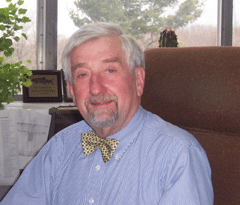
Dr. David Carpenter is a Professor of Environmental Health and Toxicology at SUNY-Albany. (Courtesy of Institute for Health and the Environment/ SUNY-Albany)
GELLERMAN: Among the most pernicious substances ever created is a group of chemicals known as POPs or Persistent Organic Pollutants. Among them: DDT, dioxins, PCBs and Chlordane. And even though twelve POPs – the so-called “dirty dozen” were restricted or banned by international convention in 2003, they continue to pose a threat to people and wildlife because POPs accumulate in the food we eat. Virtually every person on the planet has POPs in their body and the chemicals have been linked to cancers, birth defects and disabilities. Now a group of researchers in Korea have found strong evidence linking POPs and diabetes.
David Carpenter, Professor of Environmental Health and Toxicology at the State University of New York at Albany, reviewed the Korean study for Living on Earth. So, Dr. Carpenter just how strong a relationship did the Korean scientists find between diabetes and POPs?
CARPENTER: Well, one considers individual pollutants the magnitude was between three and five fold increased risk but the most striking observation was when they considered the sum of all six pollutants that they monitored and they selected pollutants that we all have in our bodies so that very few individuals had levels below the level of detection. Under those circumstances they were getting increased risk of the order of thirty-eight fold which is absolutely enormous.

Dr. David Carpenter is a Professor of Environmental Health and Toxicology at SUNY-Albany. (Courtesy of Institute for Health and the Environment/ SUNY-Albany)
GELLERMAN: Well what does that mean? Does that mean the higher your exposure to these kinds of chemicals the higher your likelihood of getting diabetes is?
CARPENTER: Well the authors are very careful to not say directly that the presence of diabetes is caused by exposure to these chemicals. Clearly the authors think that that is the case, but no single study is going to prove that. The most interesting observation in this paper is that there was no relationship between being obese and developing diabetes in those persons that did not have high levels of these organic pollutants in their bodies.
GELLERMAN: Well, how do you explain that? I always thought, well, the fatter you were the higher the likelihood that you’d get diabetes.
CARPENTER: Well that certainly is the general medical view because there is a strong association between obesity and diabetes, but it may well be that people that are obese eat much more animal fat than people that are not obese and these persistent organic pollutants are all found in animal fats. So the question really is whether it is the obesity that leads to the diabetes or rather the presence of these persistent organic pollutants. It may well be that it’s the pollutants that cause the diabetes, not the obesity.
GELLERMAN: Or it could be diabetes causes a higher buildup or retention of these POPs.
CARPENTER: That is correct and the, the authors make that statement and clearly don’t expect that that’s the explanation but their study does not disprove that that’s a possibility.
GELLERMAN: So what could be the mechanism by which these pollutants are related to diabetes?
CARPENTER: Well, certainly there is nothing in this paper that definitively identifies a mechanism. But we do know a number of actions of these compounds that suggest possible mechanisms. When these compounds bind to the liver they induce various genes. Some of those genes are involved in regulation of glucose uptake into cells and we think that it is that process that leads to this disruption of glucose regulation and causes diabetes.
GELLERMAN: Now, 20 million Americans have diabetes and we all have these POPs in us but how come not all of us get diabetes?
CARPENTER: Well, we don’t have these POPs in our bodies at the same concentration and that’s the strength of this particular study. The amount of persistent organic pollutants in each person’s body is a reflection of their diet, where they live, what the concentration of these substances is in the air they breathe, and probably related to how rapidly they metabolize these compounds.
GELLERMAN: Now, these compounds have been banned for many years by international convention.
CARPENTER: That’s correct, yes. The Stockholm Convention and, well in the US for example PCB manufacture was banned in 1977 and DDT and these other pesticides were banned even before that, however they are very persistent. They have been continued to be manufactured in some parts of the world until relatively recently and the dioxins are byproducts of combustion so they still are produced. And in the human body these compounds last about ten years before you get rid of half of them. In the environment they’re even more persistent.
GELLERMAN: So what can we do with this information?
CARPENTER: Well I think there are a number of things. We’ve got to get these compounds out of our environment and that requires political action and that’s not easy to do and it’s not inexpensive. We have many contaminated sites filled with things like PCB’s and dioxins that have not been cleaned up and remediated. I’ve already indicated that reducing our consumption of animal fats is an important thing that one could do.
GELLERMAN: You know Dr. Carpenter, as I hear you talk about this it seems this is the revenge of Silent Spring. That Rachel Carson had it absolutely correct 50 years ago.
CARPENTER: That’s absolutely right. This is the same issue from Silent Spring. We have not really appreciated how dangerous these substances are to human health. The diseases most people of, diabetes, heart disease, cancer, these are the chronic diseases of old age. All of these diseases are aggravated, increased, we’re more susceptible to them when we’re exposed to these compounds and now we’re reaping the grim harvest of the exposure that we all have to these compounds.
GELLERMAN: Dr. Carpenter, I want to thank you very much.
CARPENTER: My great pleasure.
GELLERMAN: Thank you very much.
GELLERMAN: Dr. David Carpenter is a Professor of Environmental Health and Toxicology at the State University of New York at Albany.
Related links:
- “A Strong Dose-Response Relation Between Serum Concentrations of Persistent Organic Pollutants and Diabetes. Results from the National Health Examination Survey 1999-2002” in Diabetes Care 29:1638-1644
- “Persistent Organic Pollutants and the Burden of Diabetes” by M. Porta in The Lancet - Vol. 368, Issue 9535, 12 August 2006, Pages 558-559
[MUSIC: Hulk “We Ran” from ‘Silver Thread of Ghosts’ (– 2006)]
GELLERMAN: Coming up: a close encounter of the whale kind. Keep listening to Living on Earth.
[MUSIC: Ian Boddy “If All The World Was Blue” from ‘Elemental’ (DIN - 2006)]
Conserving the Rainforest

Squirrel monkey, Jari River, Tumucumaque Mountains Naitonal Park,Amapa State, Brazilian Amazon. (Photo: Zig Koch)
GELLERMAN: It’s Living on Earth. I’m Bruce Gellerman. An innovative deal would help create the world’s largest tropical rainforest preserve. In the Brazilian state of Para, an agreement between environmental groups and the government establishes seven new protected areas in the Northern Amazon, setting aside 15 million hectares or 58 thousand square miles of some of the wildest, lushest rainforest on Earth. It’s an area the size of England but, and here’s the but, the deal also includes plans for sustainable development in some parts of the region. Dr. Claudio Maretti is head of the Program on Protected Areas for the World Wildlife Fund in Brazil. Dr. Maretti, thank you for talking with us.

Squirrel monkey, Jari River, Tumucumaque Mountains National Park, Amapa State, Brazilian Amazon.(Photo:© Zig Koch.)
GELLERMAN: This sounds like a spectacular place. It’s vast. It’s filled with incredibly diverse wildlife. What does it look like?
MARETTI: Well, we have to understand when we talk about the Amazon, it’s so immense that the diversity is also there. So we are talking about large rivers but also smaller creeks that are combining themselves in three different systems of waters. So we have black waters, transparent waters like the Caribbean, and this most known muddy waters from the Amazonas River. In terms of the land, also we have areas like open grasslands, natural grasslands; Savanna-like ecosystems. But when you get really in the middle of the jungle the feeling that you have is that you are under shelter. You know, you have this immense forest over you. Sometimes you cannot see the sky and you feel welcome there, you are not an enemy of this place if you are not coming and destroying it.
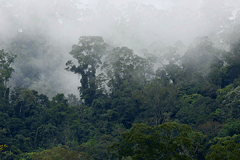
Mist shrouded rainforest along the Jari River, Tumucumaque Mountains National Park, Amapa State, Brazilian Amazon.(Photo: © Zig Koch)
MARETTI: Well, I think it’s a long process, a political process that have to involve a lot of different social actors. But at the end we need to consider different uses combined that can save the Amazon. So, we need some strict preservation areas and we need support to implement those areas in the field with patrolling, science and other activities. But we also need a kind of forest economy to be developed because surrounding those strict preservation areas we need to still keep the forest but using economically the resources from the forest.
GELLERMAN: So the way I understand it, you’re preserving large areas of land that not even tourists are going to go in. But in some areas you’re actually going to allow production.
MARETTI: That’s correct. The decision that was taken by the government of the Para State set aside some six million hectares of areas that are not even allowed for tourism just for protection and science. But together with that there is more than seven million hectares of areas that are not supposed to be converted into agriculture fields or grass lands for cattle ranching. But they do allow through a process of planning and adequate management the forest to be used economically by local communities and even companies. We need to survey that. We need to be there together with them. But it’s important to have this economic use together with strict preservation to be able to save the Amazon.
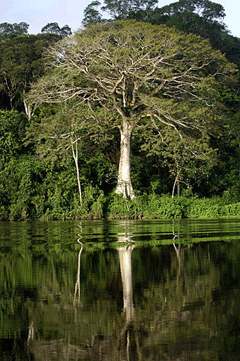
Kapok (or Sumauma) tree on the banks of the Jari River, Tumucumaque Mountains National Park, Amapa State, Brazilian Amazon. (Photo: © Zig Koch)
MARETTI: That’s absolutely correct. You can not put one thing against the other. The solution is to find the good way to develop, the good way to give economic value for that and not to be against it.
GELLERMAN: How did the locals react to this plan? I mean a lot of times they’re the ones cutting down the trees.
MARETTI: Well, yes but that’s linked to national market or sometimes international market for the economy. I mean people are going to cut the trees to sell because somebody is buying. I would say that currently what they are asking us to help them establish a legal framework for their activities. So there is enough room for legal timber industry to have a place and at the same time there is enough room for areas to be strictly preserved.
GELLERMAN: This is a very troubled place. I mean there have been clashes with activists, locals, global businesses over land rights. There was the American nun, Dorothy Stang, she was murdered in that region just last year.
MARETTI: That’s correct. In the southern part of Para we have maybe the highest rates of murders in rural areas in Brazil and that’s one of the highest in the world as well. But that’s alliance that we need to do, you know. People that are caring for conservation need to go together with local community and find a solution together. That’s why this general land use guideline setting is so important. We need to organize land use and have areas for different kind of activities. But they need to be adequate to the forest. We don’t want, you know, this kind of uses that are against the forest to come to the Amazon. Let’s protect it for the future generations.
GELLERMAN: Dr. Claudio C. Maretti is head of the program on protected areas for the World Wildlife Fund in Brazil. Dr. Maretti, thank you very much.
MARETTI: Thank you.
Related link:
World Wildlife Fund: Latin America and Caribbean
Transient Paper
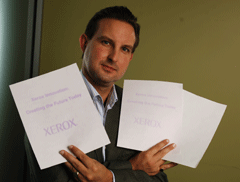
“Paul Smith, manager of XRCC’s new materials design and synthesis lab, shows the 16-hour disappearing capabilities of the temporary documents.” (Photo: Greig Reekie)
[DRUMROLL]
ANNOUNCER: And now the Amazing Gellermano presents the disappearing document. A trick that will astonish you and your friends. Ladies and Gentlemen, watch the writing vanish before your very eyes!!!
GELLERMAN: It seems that scientists at Xerox Research Center of Canada have invented paper that erases itself. Paul Smith is manager of the center in Toronto and he joins me on the line. Dr. Smith, how does it work?
SMITH: This is a printer that doesn’t use toner or ink. This is a printer that actually creates an image on the paper using light. So it’s a special printer that has a light bar in it. And the part that makes the image is actually the piece of paper. So the paper has a coating on it that when the light hits the coating the coating changes color from colorless to black. And then over a length of time, about a day, the black color then goes back to the original colorless form so that you can use it again.

Paul Smith, manager of XRCC’s new materials design and synthesis lab, shows the 16-hour disappearing capabilities of the temporary documents. (Photo: Greig Reekie)
SMITH: It lasts between 16 to 24 hours and then the page is blank. Or if you’d like to use it again within a few minutes of just being printed you can just feed it back into the printer and the image is erased and you can rewrite onto the paper again.
GELLERMAN: What if you want to keep the image?
SMITH: The image only lasts for actually the day and then it’s colorless. So if you wanted to keep the image then the ideal thing to do is to print it using your normal form using toner or ink.
GELLERMAN: Now you see it, now you don’t.
SMITH: Yes, that’s right.
GELLERMAN: And, can you use the paper over and over and over again?
SMITH: Yes, we’ve used the paper between 20 and 50 times.
GELLERMAN: So, this really is kind of the ultimate in recycling.
SMITH: Yes, I think people really like paper. They like the feel of it and they like the ability to write on it and just the general usefulness of it. But ideally they would like to perhaps not to have to throw away so much. Yeah, this is really, a recyclable paper.
GELLERMAN: I know in our office we go through a lot of paper and I use it just you know for as long as it takes me to do a story then I toss it out and put it in the recycling bin.
SMITH: Yeah, we looked at all the applications when we did a study on the way people use paper. And people use paper for things in the office. Things like just printing out a daily calendar or perhaps the e-mail they take to the meeting or the agenda. Or in the case where they use it the shortest length of time is just the cover page that comes out of the print job. So there are many applications that really just use the paper just for the one day.
GELLERMAN: You know when you write those love letters professing eternal love you want to make sure then it’s not on one of these pieces of paper.
SMITH: Yeah, yes. In our trial printer we have a, you pick the tray that you want to print the transient page on. So if you want to keep it you’ll tell the printer that you want to use just normal toner and ink. And if you want it to be a transient page you tell the printer that this needs to be a transient document and it will pick the correct paper path.
GELLERMAN: When is this going to be available in a printer near me?
SMITH: Really this is still in the development phase. So we’re looking at a few years away.
GELLERMAN: Well, Dr. Smith, thank you very much.
SMITH: Thanks very much for having me.
GELLERMAN: Paul Smith is laboratory manager of Xerox research center of Canada.
Related link:
“Experimental Xerox Paper Erases Itself, Results in Temporary Documents on Reusable Paper”
Listener Letters
GELLERMAN: From disappearing documents to memorable mail. Time now to hear from you, our listeners.
[LETTERS THEME]
When you’re eight feet tall and 900 feet long, it’s hard not to attract a lot of attention. And our story about the giant neon conceptual artwork that spells out “It is green thinks nature even in the dark” along the New Jersey Turnpike caught the attention of Andrea Palmer. She listens to the show on WHYY in Kennett Square, Pennsylvania and writes that she was bothered by the use of electricity to spread a message about global warming.
And we got a lot of feedback about our segment on the controversy over the global warming film “An Inconvenient Truth.” The National Science Teachers Association turned down the producer’s offer of 50,000 free DVD’s of the documentary. Our story led to a discussion among grad students at a Purdue University party that Sally Grant attended.
GRANT: And one of the post docs mentioned that he had been listening to Living on Earth and he had felt that neither the producer of An Inconvenient Truth, nor the President of the NSTA had acquitted themselves very well.
GELLERMAN: And how did you feel about that?
GRANT: When I first heard the segment I actually agreed with him to the point that I sat down and sent an email before it was even over to Living on Earth because as a former teacher and current member of the National Council of Teachers of English. I felt that the real issue was being obscured. If the NSTA is seen as endorsing particular movies or textbooks or points of view it becomes a very slippery slope where the NSTA is being seen as speaking for all science teachers.
GELLERMAN: You can speak to us – we’ll listen. Call our listener line anytime at 800-218-9988. Our email address is comments at loe dot org. That’s comments at loe dot org.
A Whale of a Tale
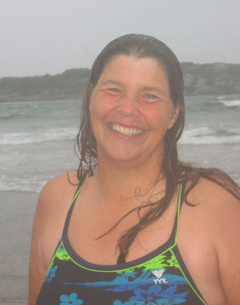
In her element: Lynne Cox after a swim at Good Harbor Beach in Gloucester, MA. (Photo: Ashley Ahearn)
GELLERMAN: You might say Lynne Cox is more at home in the water than she is on land.
COX: There’s something really serene about swimming through black water where the sea and the sky sort of blend together and so you sort of feel like you’re swimming across sheets of the cosmos in a way.
GELLERMAN: Lynne Cox broke the record for the fastest swim across the English Channel when she was just 15. She swam the Bering Strait –from Alaska to Siberia--during the Cold War to encourage peace between Russia and the United States. And without a wetsuit or fins, she swam a mile in the Antarctic Ocean in 32-degree water.
BRRRRRR.
But there’s one nautical experience Lynne Cox will never forget. It happened when she was a teenager, training in the dark waters off the coast of California before dawn.Lynne Cox has written about the experience in her new book called “Grayson.”
That’s the name she gave the whale she encountered that morning so many years ago.
[MUSIC: Yo-Yo Ma “Unaccompanied Cello Suites 1-3 (various selections)” from ‘Bach: The Cello Suites’ (Sony Music – 1997)]
COX: When I was training one morning off the coast of Seal Beach when I had this baby gray whale that I wound up calling Grayson swimming with me. I didn’t know at first what it was. And so, to be swimming along and I feel the water hollow out underneath me and being sucked down into that little hole and being dragged along by the slipstream, I was really scared! And I really had to talk myself down and not just turn and swim out of the water as fast as I could. I had to sort of say, “Well it could be a seal, it could be a dolphin,” and then the mind goes, “Well it could be a shark!” (laughs)

In her element: Lynne Cox after a swim at Good Harbor Beach in Gloucester, MA. (Photo: Ashley Ahearn)
[MUSIC: Yo-Yo Ma “Unaccompanied Cello Suites 1-3 (various selections)” from ‘Bach: The Cello Suites’ (Sony Music – 1997)]
COX: You know then I would talk to myself and say, “Ok, so I’m a little closer to shore because if it is a shark you can then get out of the water quickly”. So, I turned toward the surf line and I looked up and I saw Steve, the old man who ran the bait shop who was a fisherman and knew everything about the ocean. And he was waving his arms frantically at me. And I thought, “Yup it was a shark. It’s time to get out now”. And then and then he shook his head. And so I looked closer and he was cupping his hands around his mouth and he was shouting at me and he was saying, “Lynne, you can’t finish your work out now. You’ve got a baby gray whale. He’s lost and if you go a shore he’ll follow you, he will go aground and he will die. You have to stay out here and help him find his mother”.
[MUSIC: Yo-Yo Ma “Unaccompanied Cello Suites 1-3 (various selections)” from ‘Bach: The Cello Suites’ (Sony Music – 1997)]
COX: I didn’t know how you find a mother whale in the middle of the Pacific Ocean. But you know, I was only 17 then. So I would sort of think, ok I can do it. I’m not sure yet how, but maybe if I just try there will be a way to figure out that we can do this.
[MUSIC: Yo-Yo Ma “Unaccompanied Cello Suites 1-3 (various selections)” from ‘Bach: The Cello Suites’ (Sony Music – 1997)]
COX: Then he tried to communicate. He swam over and rolled over and looked at me with one big brown eye. And I looked at him and I thought, oh my gosh he’s looking at me. And you know, he was huge. He was eighteen feet long. And I’m sort of all at once wanting to just touch him and comfort him. And at the same time I’m thinking he’s 18 feet long! Oh my gosh! And so he came very close to me and then would swim away. And then I decided well, you know, you learn in life that sometimes just being with somebody else will make all the difference in the world. So, I decided that I would just stay with him. And maybe by doing that we could together find his mother.
[MUSIC: Yo-Yo Ma “Unaccompanied Cello Suites 1-3 (various selections)” from ‘Bach: The Cello Suites’ (Sony Music – 1997)]
COX: I’d been off shore for about four hours with Grayson and realized that I was really cold and really tired and I needed to get back to shore because I wasn’t going to be ok otherwise. And so, I started swimming towards shore and he realized that. And he swam closer to me like when you swim in the water and you swim close to a friend you get a good drag off them and your swimming is a lot easier. So he swam really close and allowed me to swim in his slipstream.
[MUSIC: Yo-Yo Ma “Unaccompanied Cello Suites 1-3 (various selections)” from ‘Bach: The Cello Suites’ (Sony Music – 1997)]
COX: We made it back to the pier where there were people on the pier watching. And in the mean time the lifeguards who patrol the area had called each other to tell their friends to be on the look out for a lone female whale, gray whale. Who might be somewhere off shore. The fishermen also had radioed their friends. And we got a report there at the end of the pier that ten miles off us, in Huntington Beach, was a gray whale female that was heading towards Seal Beach. And I think that she must have heard Grayson’s calls.
[MUSIC: Yo-Yo Ma “Unaccompanied Cello Suites 1-3 (various selections)” from ‘Bach: The Cello Suites’ (Sony Music – 1997)]
COX: When he came over to me it was obvious to me that he was asking me for his help. And I felt like I could do something. And that’s really one of the big reasons why I wrote this story because I figured out that in life we have big moments- really big moments-where we have a choice of doing something or letting it go by. And I think that that whole episode of being with the whale was really key to everything that I would do through the rest of my life. Because I realized that I could do something, that I could have an impact. And if I tried I would get a little bit closer with him to whatever we wanted to accomplish.
[MUSIC: Yo-Yo Ma “Unaccompanied Cello Suites 1-3 (various selections)” from ‘Bach: The Cello Suites’ (Sony Music – 1997)]
GELLERMAN: Author Lynne Cox. Her book about her experience with the baby gray whale is called “Grayson.” Our story was produced by Living on Earth’s Ashley Ahearn.
Related link:
Lynne Cox’s website
Just ahead: Eureka! – but have they found it? –the holy grail of car batteries.
First this note on emerging science from Jennifer Percy.
Emerging Science Note/Better Breathing Babies
[SCIENCE NOTE THEME]
PERCY: Do you have a sick baby at home? Living with dogs may be just the prescription your child needs. According to scientists at the University of Cincinnati, infants are two times less likely to have allergic reactions like wheezing in their first year of life if they live in a home with two or more dogs.
Scientists studied 520 infants who were at risk for developing allergies. They collected dust samples from the infant’s homes and measured levels of an allergen called endotoxin. They then used skin pricks to monitor the infant’s responses to the samples.
Researchers found no relationship between reduced allergies and exposure to endotoxin but did find that having dogs and high levels of endotoxin reduced wheezing.
They aren’t yet sure why a dog’s presence in combination with endotoxin exposure is beneficial to infants. Further studies are in the works to determine whether dog ownership will have long term benefits for the immune system.
But in the meantime if you’re having a baby, you might want to make some canine friends. That’s this week’s note on emerging science. I’m Jennifer Percy.
Related link:
“Infants Wheeze Less In Homes With Multiple Dogs”
GELLERMAN: And you’re listening to Living on Earth.
ANNOUNCER: Funding for Living on Earth comes from the Cedar Tree Foundation and from Trinity University Press, publishers of “Wisdom for a Livable Planet” by Karl McDaniel, a Collection of Profiles of Environmental Visionaries. For more information go to www.trinity.edu/tupress. This is Living on Earth on PRI, Public Radio International.
Independent Nation
GELLERMAN: It’s Living on Earth. I’m Bruce Gellerman. To reach its goal of oil independence by the year 2020, the Swedish government is offering drivers incentives for using alternative fuels. Fuels such as E85, a mixture of 85 percent ethanol - a renewable fuel made from crops - and 15 percent petroleum.
As Lars Bevanger of Radio Deutsche Welle reports from Stockholm, Sweden’s use of so-called biofuels is leaving drivers in other countries in the dust.
[CAR DOOR SLAMS]
BEVANGER: This is it. It looks just like a normal Saab.
OLSLON: That’s the point. It is a normal Saab and it travels like a normal Saab.
BEVANGER: Arian Olslon from Saab takes me for a drive in what looks exactly like a normal car from the Swedish carmaker. Only a tiny badge that says “bio-power” on the back gives the game away. Instead of petrol this car runs mainly on ethanol.
OLSLON: We saw this opportunity on the market and since the investment you had to do with research and development on the car for launching this version, it wasn’t such a vast sum actually. And the increase in price for the customers is also quite low actually. So, I don’t see no reason why you shouldn’t buy this version if you are considering a Saab 9-5.
[TRAFFIC SOUNDS]
BEVANGER: The sale of so-called green cars has skyrocketed here in Sweden. It’s increased by 340 percent just in the past year. If this continues, soon one in five new cars will run on environmentally friendly fuel. Other European countries are nowhere close to this development. So what is it with the Swedes? Eva Somersett works with environmental affairs for the city of Stockholm.
SOMERSETT: One thing is that these vehicles are available on the market. They are here and they are working. They are exactly like a conventional vehicle. We also have economical incentives for these; no tax on clean fuels in Sweden. There’s also carrots like free parking in various cities and municipalities in Sweden.
[GAS PUMPING SOUND]
BEVANGER: The most popular alternative fuel here is the E-85; a mix of 15 percent petrol and 85 percent ethanol. Ethanol is made from renewable resources like sugar cane, wheat, or trees. Sweden’s larger filling stations are now obliged to offer this fuel by law. That’s good news for big car producers like Saab, which has invested a lot in production of ethanol cars. Arian Olslon from Saab again.
OLSLON: We have more than 500 ethanol pumps here in Sweden and along the main roads you can always find ethanol I would say.
BEVANGER: And if you can’t find ethanol, are you stuck then? You can’t go anywhere in this car?
OLSLON: Not at all. Then I just fill it up with normal petrol and drive on. That’s the beauty of it. But why should I do it? I always try to find the ethanol because it not only reduces the carbon dioxide, it also makes the car more fun to drive.
BEVANGER: With so many people turning to cleaner cars it seems this country is really serious about finding alternatives to oil. Just how serious became clear earlier this year when the then Prime Minister Goran Persson announced this to parliament.
PERSSON: (Swedish translated to English) We shall get out of our oil dependency. We shall become independent of oil, and it shall happen by the year 2020.
BEVANGER: This plan relies heavily on a massive increase in the use of alternative fuels like ethanol. But critics say there simply won’t be enough space to produce ethanol in large quantities. Steven Hinton is a Stockholm-based consultant on environmental affairs.
HINTON: The solution for mass transport, I don’t think it’s realistic. You’d have to produce ethanol and not food. We would be scouring Sweden for every single tree we could find, every field we could find, just to support this incredible energy intensive way we live.
BEVANGER: Mr. Hinton argues the only way forward is not to replace fossil fuels with alternatives but to replace our dependency on cars. Eva Somersett of the city of Stockholm disagrees.
SOMERSETT: It’s very hard to change the infrastructure in a city when they’re already there. There’s no farmer within the boarders of Stockholm so where are we going to get the food? We need to transport it in and of course we can use trains and so on to a certain extent. But I still think that in the future we will have trucks and cars. But I do believe that we will not have fossil fuels in these vehicles.
[CAR DOOR SLAMS, ENGINE STARTS]
BEVANGER: As long as ethanol cars aren’t much more expensive to buy and the fuel remains slightly cheaper than petrol the sale of such cars looks set to continue to rise here. And for now at least, most Swedes seem to worry more about the shortage of oil than a future shortage of ethanol.
GELLERMAN: Our report was produced by Lars Bevanger and comes to us from Radio Deutsche Welle.
Related link:
Deutsche Welle Radio
Driving Electric

Phoenix Production Sport Utility Truck (SUT). (Phoenix Motorcars)
GELLERMAN: When General Motors, Toyota, and Ford decided to pull the plug on their electric vehicles, it seemed to toll a death knell for cars powered by batteries.But there’s still a charge left in the fledgling technology. Today, there are a number of small startups trying to resurrect the electric vehicle, though most of the models are just for city-driving or very expensive. But as Living on Earth’s Ingrid Lobet reports, there is one car company, called Phoenix Motorcars, that is rising above the others, with plans to sell long-range, relatively affordable electric vehicles - in the coming year a pickup truck, and an SUV in 2008.
[BUZZING SOUND]
LOBET: In a building on the outskirts of Los Angeles, engineers test and tweak Phoenix Motorcars' first run of electric sports utility trucks. Salesman Brian Bliss points out the slanty headlights framing a V-shaped black grill.
.gif)
Phoenix Production Sport Utility Truck (SUT). (Phoenix Motorcars)
LOBET: Most electric cars - though not all - have been small, like pumped up golf carts, or sporty two-seaters, but both Phoenix models can fit 5 passengers plus cargo.
BLISS: These are full size cars, comparable to any gas powered vehicle you'll see on the road today.
LOBET: Phoenix thinks it can offer a bigger car because it's using a new battery. It gets its batteries from a chemicals firm in Reno, Nevada - Altairnano. The company discovered a battery chemistry that solves the not-so-little problem of lithium batteries getting too hot and bursting into flames - like the laptop batteries recently in the news. Phoenix CEO Dan Elliot:
ELLIOT: The lithium titanate, or nano-safe battery, removes the carbon content from the battery, it takes the graphite out, and by doing that, it cannot, because of its physical chemistry, get into a thermal runaway issue, so you can’t actually have that tremendous heat up and then a fire like you see in a standard lithium battery.
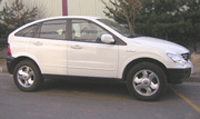
Phoenix Production Sport Utility Vehicle (SUV).(Phoenix Motorcars)
HOUSE: You can take the energy out very quickly and you can put it back in very quickly and the life does not degrade. It's a quantum leap, it's a paradigm-shifting leap.
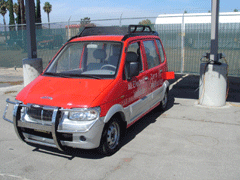
A Miles OR70 demonstrates its zero pollution capability by charging at a solar panel array at MCB Camp Pendleton. (Photo: Miles Automotive Group)
LOBET: Phoenix is starting to get the kind of celebrity attention that startups can only dream of and that helped launch the Toyota Prius a few years ago. Here actor Ed Begley praises the Phoenix-Altairnano combo at a clean vehicle show on the Santa Monica Pier.
BEGLEY: We have been waiting for the breakthrough batteries and I believe it's happened with these wonderful lithium ion batteries that do no have the graphite in them, it's totally different they don't have the heat issues of lithium ion batteries have had. I think we've found the Holy Grail of batteries.
LOBET: But Phoenix is still ironing out the kinks. Mechanics worked down to the wire to have one SUV ready for reporters to test-drive. They worked so long they had to leave the shop without charging it, so they brought along their mobile charger. But it turns out bringing a diesel generator onto the Santa Monica pier for a clean car event is a no-no.
The idea of a new electric car and this new battery technology does have its skeptics. Marshall Miller, Senior Development Engineer at UC Davis' Institute for Transportation Studies is one.
MILLER: Lithium Ion batteries have been around for a while and we have tested them in our labs for at least five years now, and the properties of the batteries, with the exception of cycle life, have not changed significantly. The real problem has been the cost, and potentially, the cycle life. The big question is, as you bring the price down, how low can you get it? Is that price low enough to be mass marketable? And I think that’s something that no one really knows at this point.
LOBET: Phoenix is selling its trucks and SUV’s for 45 thousand dollars, which will still be a loss for the company in the beginning. Another question is whether Americans, just catching on to hybrids, will want to buy an all battery car, even if it can go as long on a charge as a car goes on a tank of gas, because then you’d have to recharge. But Phoenix foresees a day when you can go to the gas station for either a fill-up or a charge up, and either would take the same time. Altairnano Senior VP Roy Graham says major automakers are showing interest.
[CROWD ON A PIER]
GRAHAM: Given the technical characteristics of the batteries, all of the hybrid manufacturers and the plug-in hybrids and all the electric vehicle manufacturers are all over it, so you can assume that we’re talking to a lot of the major players as well.
LOBET: Phoenix Motorcars says it will deliver its first electric pickups in the spring. They'll be available to municipal and commercial fleets and go 100-130 miles on a charge. Consumers will be able to buy the trucks and SUV’s beginning in 2008. Those vehicles will have a double-battery pack and go twice as far.
For Living on Earth, I’m Ingrid Lobet.
Related links:
- Phoenix Motorcars
- Altair Nanotechnologies
- To read a longer interview with Marshall Miller, Senior Development Engineer, Institute for Transportation Studies, UC Davis, click here.
- To read a longer interview with Dr. Evan House, Director of the Battery Business Unit in Altairnano, click here.
- To read a longer interview with Dan Elliot, CEO, Phoenix Motorcars, click here.
- To read a longer interview with Brian Bliss, Sales, Phoenix Motorcars, click here.
Judgement Day
GELLERMAN: Heaven knows you already have a choice between gas-guzzling SUV’s and cleaner, more efficient hybrid models. Sure, both will get you to your final destination, but choose wisely or as Princeton New Jersey writer Rich Pliskin and his players tell us you could wind up paying a hell of a price.
ANNOUNCER: And now, a public service announcement.
[HARP PLAYING]
USHER: Number 471, to the right of the cloud, please. That’s it.
JANE: Kinda nervous. You?
CHUCK: Nahh! This guy's a gentle giant. You'll be OK.
JACK TRIBBLE: Oh good Lord, thank you, thank you!
JANE: Sounds like that guy’s making out OK.
CHUCK: That's Jack Tribble.
JANE: You know him?
CHUCK: Neighbor. Couldn't stand the guy. So “holier than thou” with those His and Hers hybrids. Uh, make ya’ sick.
JANE: Somebody sure likes him. Look at the attention he's getting.
USHER: Right this way, sir. Follow the sound of the harps. That’s it.
CHUCK: Huh.
JANE: Hey, look at that other guy. He must be in big trouble.
CHUCK: That’s Ken Schmertz!
USHER: Number 472: Schmertz! Sub-basement Level 5! Fast lane, no stops!
SCHMERTZ: Wait! Can we talk about this?
USHER: Let’s go, mac!
SCHMERTZ: Tell my wife–tell my wife to wax the Navigator!
JANE: Wow! Sub-basement Level 5! I wonder what he did.
CHUCK: Ken lived for his SUVs.
JANE: Ouch.
CHUCK: Yeah. Ouch.
JANE: So what about you? What line were you in?
CHUCK: Sold SUVs.
JANE: Oh, well, I’m sure it’s okay. That Schmertz fella probably just cheated on his taxes or something.
CHUCK: Yeah. I guess…What about you?
JANE: Oh, I never cheated on my taxes. That would be a sin.
CHUCK: No, what’d you do for a living?
JANE: Oh, right! I invented an affordable, solar-powered family minivan to reduce our dependence on foreign oil, reverse global warming and cut the trade deficit in half by 2007.
CHUCK: Huh.
USHER: Number 473!
JANE: Hey! My number’s up!
USHER: Right this way, ma’am. And may I say what a colorful blouse you’re wearing today?
JANE: Well, see ya’! Or, not. Hey Jack! Jack Tribble! Wait up!
ANNOUNCER: This message was sponsored by the Alternative Cars for a Better Future Foundation. We’re AC-BFF, reminding you to drive responsibly. Because someday, it just may matter.
GELLERMAN: “Divine Inspiration,” courtesy of Rich Pliskin and his players from heavenly, Princeton, New Jersey.
[Performed by: Erika Lynn Becker, Michael Gallagher, Michael Hegarty, Dan Johnson and Rich Pliskin]
[MUSIC: Johann Aratore “Organ Concerto No. 4 in F Major, Op. 4, No. 4: I. Allegro” from ‘Handel: Famous Organ Concertos’ (Naxos – 1988)]
GELLERMAN: We leave you this week in the land of the Cailleach in the dead of winter.
[EARTH EAR: “Scottish Glen (Red Deer Stags)” recorded by Richard Margoschis from ‘Wild Britain: Sound Portraits from Britain’s Wild Places’ (The British Library Board - 1997)]
GELLERMAN: In a snow-covered glen in the deep woods of Scotland, red deer stags roar next to a rushing river. Perhaps these were the sounds Bride could hear when held captive by the jealous witch. Richard Margoschis recorded this scene in Glen Meinich, Inverness.
GELLERMAN: You can hear our program anytime on our website, or get a download for your MP3 player. The address is LOE dot org. That's LOE dot O-R-G. You can reach us at comments @ l-o-e dot org. Once again, comments @ l-o-e dot O-R-G. Our postal address is 20 Holland Street, Somerville, Massachusetts, 02144. And you can call our listener line, at 800-218-9988. That's 800-218-99-88. CD's and transcripts are fifteen dollars.
GELLERMAN: Living on Earth is produced by the World Media Foundation.
Our crew includes Ashley Ahearn, Eileen Bolinsky, Tobin Hack, Ingrid Lobet, Emily Taylor and Jeff Young - with help from Bobby Bascomb, and Kelley Cronin.
Our interns are Ian Gray and Jennifer Percy. Dennis Foley is our technical director. Our executive producer is Steve Curwood. Alison Lirish Dean composed our themes. You can find us at loe dot org. I’m Bruce Gellerman. Thanks for listening.
ANNOUNCER: Funding for Living on Earth comes from the National Science Foundation, supporting coverage of emerging science; And Stonyfield Farm organic yogurt and smoothies. Stonyfield pays its farmers not to use artificial growth hormones on their cows. Details at Stonyfield dot com. Support also comes from you, our listeners, the Ford Foundation, the Wellborn Ecology Fund, and the Saunders Hotel Group of Boston's Lennox and Copley Square Hotels. Serving you and the environment while helping preserve the past and protect the future, 800-225-7676.
ANNOUNCER 2: PRI, Public Radio International.
Special: Holiday Promo/Season of Light
GELLERMAN: Next week on Living on Earth: the winter solstice is the shortest, darkest day in the Northern Hemisphere. For pagans and druids, it’s one of the most important times of year.
FREEMAN: For the ancient Celts there was really two parts of the year, the dark part, the winter part, and the summer part. And they were personified or regarded by the people in those times as two faces of a great goddess. And in the winter she was called the Cailleach which is a word meaning “the veiled one” and her bright side, which returned when spring came along, was Bride, and Bride is the young maiden who ushers back the warm light-filled days of the early spring.
GELLERMAN: The Cailleach doesn’t give up her hold on the cold, dark days easily. Celtic storyteller Mara Freeman tells her tale.
FREEMAN: All winter long the Cailleach kept captive a beautiful young princess named Bride. She was jealous of her beauty and gave her ragged clothes to wear and made her work in the kitchen of her castle in the mountains. The young girl had to perform the meanest tasks and the Cailleach scolded her constantly. Bride’s life was wretched indeed. Now the reason the Cailleach Veer kept Bride a prisoner was because her favorite son, who’s name was Angus the ever young, had fallen in love with her. The Cailleach knew that if he ever married Bride, he would be able to take his place as the Summer King, and Bride would be his queen. Then the Cailleach’s reign would be over. When she found out what had happened she and her eight hag servants mounted their shaggy black goats and rode out of the mountain to wage war upon Angus and Bride.
GELLERMAN: Will the young lovers triumph over the long, cold winter? Find out next week in “Season of Light,” Living on Earth’s Holiday Storytelling special.
[MUSIC: Mara Freeman plays the “Zither Harp” live throughout story telling (recorded at KAZU-FM, Monterey, CA. – December 2006)]
Living on Earth wants to hear from you!
Living on Earth
62 Calef Highway, Suite 212
Lee, NH 03861
Telephone: 617-287-4121
E-mail: comments@loe.org
Newsletter [Click here]
Donate to Living on Earth!
Living on Earth is an independent media program and relies entirely on contributions from listeners and institutions supporting public service. Please donate now to preserve an independent environmental voice.
NewsletterLiving on Earth offers a weekly delivery of the show's rundown to your mailbox. Sign up for our newsletter today!
 Sailors For The Sea: Be the change you want to sea.
Sailors For The Sea: Be the change you want to sea.
 The Grantham Foundation for the Protection of the Environment: Committed to protecting and improving the health of the global environment.
The Grantham Foundation for the Protection of the Environment: Committed to protecting and improving the health of the global environment.
 Contribute to Living on Earth and receive, as our gift to you, an archival print of one of Mark Seth Lender's extraordinary wildlife photographs. Follow the link to see Mark's current collection of photographs.
Contribute to Living on Earth and receive, as our gift to you, an archival print of one of Mark Seth Lender's extraordinary wildlife photographs. Follow the link to see Mark's current collection of photographs.
 Buy a signed copy of Mark Seth Lender's book Smeagull the Seagull & support Living on Earth
Buy a signed copy of Mark Seth Lender's book Smeagull the Seagull & support Living on Earth

